|

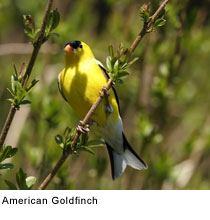 Just the Facts: "Classic finches" are small to moderately large and have a strong beak, usually conical and in some species very large. All have 12 tail feathers and 9 primaries. These birds have a bouncing flight with alternating bouts of flapping and gliding on closed wings, and most sing well. Just the Facts: "Classic finches" are small to moderately large and have a strong beak, usually conical and in some species very large. All have 12 tail feathers and 9 primaries. These birds have a bouncing flight with alternating bouts of flapping and gliding on closed wings, and most sing well.
Their nests are basket-shaped and built
in trees.
All in the Subfamily Fringillae:
The genus Fringilla is a small group of finches, which are the only species in the subfamily Fringillinae The three species, which feed their young on insects rather
than seeds. The Fringilla finches are seed-eating passerine birds restricted to the Old World. These birds have a bouncing flight with alternating bouts of flapping and gliding on closed wings, but feed largely on the ground.
All in the Subfamily Carduelinae:. The other much larger subfamily is the Cardueline finches in the subfamily Carduelinae which feed their young on seeds.
All in the Subfamily Euphonae: Euphonias are members of the genus Euphonia, a group of Neotropical birds in the finch family. They share the subfamily 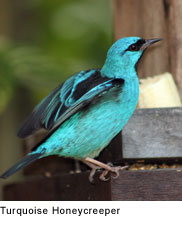 Euphoniinae with the chlorophonias. Euphonia contains close to 27 species. Most euphonias dark mettalic blue above and bright yellow below. Many have contrasting pale foreheads and white undertails. Some have light blue patches on the head and/or orangish underparts. Euphoniinae with the chlorophonias. Euphonia contains close to 27 species. Most euphonias dark mettalic blue above and bright yellow below. Many have contrasting pale foreheads and white undertails. Some have light blue patches on the head and/or orangish underparts.
All in the Subfamily(?) Drepanididae:
Hawaiian honeycreepers are small passerine birds endemic to Hawaii. Some authorities categorize this group as the subfamily Drepanidinae of the finch family Fringillidae,
to which they are closely related, but
they are usually given full family status
as the Drepanididae.
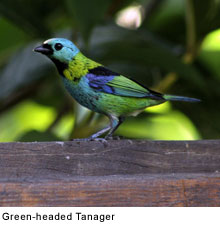 The male Hawaiian Honeycreepers are often more brightly coloured than the females, but in the Hemignathini, they often look very similar. The flowers of the native plant Metrosideros polymorpha (‘ohi‘a lehua) are favoured by a number of nectar-eating honeycreepers. The male Hawaiian Honeycreepers are often more brightly coloured than the females, but in the Hemignathini, they often look very similar. The flowers of the native plant Metrosideros polymorpha (‘ohi‘a lehua) are favoured by a number of nectar-eating honeycreepers.
The wide range of bills in this group,
from thick finch-like bills to slender downcurved bills for probing flowers have arisen through adaptive radiation, where
an ancestral finch has evolved to fill a large number of ecological niches. Some 15 forms of Hawaiian Honeycreeper have become extinct in the recent past, many more since the arrival of the Polynesians who introduced the first rats. The recent extinctions are due to the introduction of other rodent species and the mongoose, habitat destruction and avian malaria and fowlpox.
-----------------------------------------------------------------------------------------------------------------------------
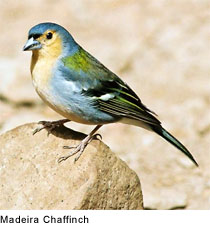 The Chaffinch: (Fringilla coelebs), The Chaffinch: (Fringilla coelebs),
is a small passerine bird in the finch
family Fringillidae.
Range: This bird is widespread and very familiar throughout Europe. Its range extends into western Asia, northwestern Africa the Canary Islands and Madeira. On Tenerife
and Gran Canaria, it coexists with its sister species, the endemic Blue Chaffinch.
The Madeiran form is a distinct subspecies, the Maderian Chaffinch,
F. c. madeirensis.
Nest and Habitat: It uses a range of habitats, but open woodland is favoured, although it is common in gardens and on farmland. It builds its nest in a tree fork, and decorates the exterior with moss or lichen to make it less conspicuous. It lays about six eggs. This bird is not migratory in the milder parts of its range, but vacates the colder regions in winter.
Should I Stay or Go? The coelebs part of its name means "bachelor". This species was named by Linnaeus; in his home country of Sweden, the females depart in winter, but the males often remain. This species forms loose flocks outside the breeding season, sometimes mixed with Bramblings. This bird occasionally strays to eastern North America, although some sightings may be escapees.
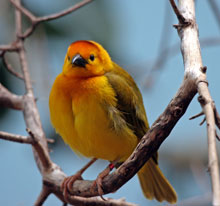 Crooners of the Bird World: The powerful song is very well known, and the fink contact call gives the finch family its English name. Males typically sing two or three different song types, and there are regional dialects too. Crooners of the Bird World: The powerful song is very well known, and the fink contact call gives the finch family its English name. Males typically sing two or three different song types, and there are regional dialects too.
The acquisition by the young chaffinch of its song was the subject of an influential study by British ethologist William Thorpe.
Thorpe determined that if the chaffinch is not exposed to the adult male's song during a certain critical period after hatching, it will never properly learn the song. He also found that in adult Chaffinches, castration eliminates song, but injection of testosterone induces such birds to sing even in November, when they are normally silent (Thorpe 1958).
Songs in Sports: In a number of countries such as Belgium, the Chaffinch is a popular pet bird, although it is nowadays forbidden to catch the birds in the wild. In some areas of Western Belgium, finching is a quite popular sport. In a finching contest, a number of cages each housing a male finch are lined up, usually along a street. Every time the bird sings its song (which should be the correct tune!) this is marked with a chalk stripe on a wooden stick, and the bird singing its song the most times during one hour wins the contest.
-----------------------------------------------------------------------------------------------------------------------------
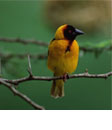 There are many other birds in other groups which are called finches, notably the very similar-looking Estrildids or waxbills, which occur in the Old World tropics and Australia. There are many other birds in other groups which are called finches, notably the very similar-looking Estrildids or waxbills, which occur in the Old World tropics and Australia.
The estrildid finches are small passerine birds of the Old World tropics and Australasia.
They can be classified as the family Estrildidae (weaver-finch) or as a sub-group within the family Passeridae, which also includes the true sparrows.
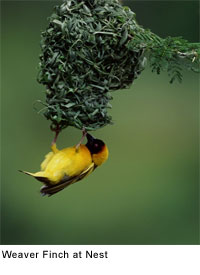 Weaver Finch: They are gregarious and often colonial seed-eaters with short thick but pointed bills. They are all similar in structure and habits, but have a wide variation Weaver Finch: They are gregarious and often colonial seed-eaters with short thick but pointed bills. They are all similar in structure and habits, but have a wide variation
in plumage colours and pattern. Most are sensitive to cold and require a warm, usually tropical, habitat, although a few have
become adapted to the cooler climates of southern Australia.
Intricate Nests: All the estrildids build large domed nests and lay 5-10 white eggs. Many species build roost nests Some of the fire-finches and pytilias are hosts to the brood parasitic indigobirds and whydahs respectively.

Family Fringillidae
Subfamily Fringillinae - Fringilline finches; contains only three species, which feed their young on insects rather than seeds.
Genus Fringilla - Bramblings and chaffinches
-------Chaffinch (Fringilla coelebs)
-------Blue Chaffinch (Fringilla teydea)
-------Brambling (Fringilla montifringilla)
Subfamily Carduelinae - Cardueline finches; a much larger group that contains several genera which feed their young on seeds.
Genus Serinus - Canaries, seedeaters, serins and some siskins
Genus Carduelis - Linnets, redpolls, goldfinches, greenfinches, some siskins.
Genus Carpodacus - Rosefinches
Genus Loxia - Crossbills
Genus Mycerobas - Grosbeaks
Genus Neospiza - Sao Tomé Grosbeak
Genus Linurgus - Oriole Finch
Genus Rhynchostruthus - Golden-winged Grosbeak
Genus Leucosticte - Mountain finches
Genus Callacanthis - Red-browed Finch
Genus Rhodopechys - Trumpeter Finch and relatives
Genus Uragus - Long-tailed Rosefinch
Genus Urocynchramus - Przewalski's Rosefinch
Genus Chaunoproctus - Bonin Grosbeak (extinct)
Genus Pinicola - Pine grosbeaks
Genus Haematospiza - Scarlet Finch
Genus Pyrrhula - Bullfinches
Genus Coccothraustes - Hawfinch, Evening Grosbeak
Genus Eophona - Oriental grosbeaks
Genus Pyrrhoplectes - Gold-naped Finch
Subfamily Euphoniinae - Euphonious finches; endemic to the Neotropics; formerly treated in Thraupidae.
Genus Euphonia, the euphonias
-------Jamaican Euphonia, Euphonia jamaica
-------Plumbeous Euphonia, Euphonia plumbea
-------Scrub Euphonia, Euphonia affinis
-------Purple-throated Euphonia, Euphonia chlorotica
-------Yellow-crowned Euphonia, Euphonia luteicapilla
-------Trinidad Euphonia, Euphonia trinitatis
-------Velvet-fronted Euphonia, Euphonia concinna
-------Orange-crowned Euphonia, Euphonia saturata
-------Finsch's Euphonia, Euphonia finschi
-------Violaceous Euphonia, Euphonia violacea
-------Thick-billed Euphonia, Euphonia laniirostris
-------Yellow-throated Euphonia, Euphonia hirundinacea
-------Green-chinned Euphonia, Euphonia chalybea
-------Elegant Euphonia, Euphonia elegantissima
-------Antillean Euphonia, Euphonia musica
-------Golden-rumped Euphonia, Euphonia cyanocephala
-------Spot-crowned Euphonia, Euphonia imitans
-------Fulvous-vented Euphonia, Euphonia fulvicrissa
-------Olive-backed Euphonia, Euphonia gouldi
-------Bronze-green Euphonia, Euphonia mesochrysa
-------White-lored Euphonia, Euphonia chrysopasta
-------White-vented Euphonia, Euphonia minuta
-------Tawny-capped Euphonia, Euphonia anneae
-------Orange-bellied Euphonia, Euphonia xanthogaster
-------Rufous-bellied Euphonia, Euphonia rufiventris
-------Golden-sided Euphonia, Euphonia cayennensis
-------Chestnut-bellied Euphonia, Euphonia pectoralis
Genus Chlorophonia, the chlorophonias
-------Yellow-collared Chlorophonia, Chlorophonia flavirostris
-------Blue-naped Chlorophonia, Chlorophonia cyanea
-------Chestnut-breasted Chlorophonia, Chlorophonia pyrrhophrys
-------Blue-crowned Chlorophonia, Chlorophonia occipitalis
-------Golden-browed Chlorophonia, Chlorophonia callophrys
Subfamily Drepanidinae - Hawaiian honeycreepers
All text is available under the terms
of the GNU Free Documentation License
|